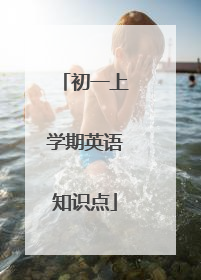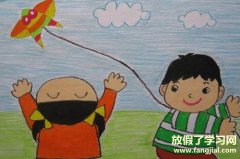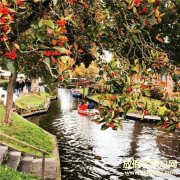初一上册英语知识点归纳总结
初一上册英语知识点归纳总结1 一、48个国际音标及26个英文字母的正确书写 要熟练掌握元音和辅音,5个元音字母(a, e, i, o, u),字母的正确占格及单词间距。 二、be动词的用法 be动词有三种变形,分别是:am, is, are。记忆口诀: “我”用am, “你”用are, is用于“他、她、它”;单数全都用is,复数全部都用are。 三、人称及人称代词的不同形式(主格和宾格) 1、三种人称:第一人称(I, we),第二人称(you, you),第三人称(he, she, it, Maria)。 2、人称代词的主格,即人称代词位于句子主语位置时的形态:I, We, You, You, He, She, It, Maria。 3、人称代词的宾格,即人称代词位于句子宾语位置时的形态:me, us, you, you, him, her, it。 4、形容词性物主代词:my, our, your, your, his, her, its, their。 5、名词性物主代词:mine, ours, yours, yours, his, hers, its, theirs。 6、反身代词:myself, ourselves, yourself, yourselves, himself, herself, itself, themselves。 初一上册英语知识点归纳总结2 一、基数词(表示数量多少的词,大致相当于代数里的自然数) zero, one, two, three, four, five, six, seven, eight, nine, ten, eleven, twelve, thirteen, fourteen, fifteen, sixteen, seventeen, eighteen, nineteen, twenty, twenty-one, twenty-two, twenty-three,twenty-four, twenty-five, twenty-six, twenty-seven, twenty-eight, twenty-nine, thirty, forty, fifty, sixty,seventy, eighty, ninety, one hundred,one hundred and one。 二、一般疑问句及特殊疑问句 1、一般疑问句:能用Yes或No来回答的问句。一般疑问句句尾读升调。 2、特殊疑问句:不能用Yes或No来回答的问句。特殊疑问句句尾读降调。 三、可数名词变复数 可数名词变复数时,有规则变化和不规则变化两种。 1、规则变化: 1)一般情况直接在词尾加“-s ”,如:cake-cakes, bag-bags, day-days, face-faces, orange-oranges等; 2)以s, x, sh, ch结尾的词,要在词尾加“-es ”,如:bus-buses, watch-watches, box-boxes等; 3)以辅音字母加y结尾的词,变y为i再加“-es ”,如:baby-babies, country-countries, family-families等; 4)部分以f (e)结尾的词,变f (e)为“ves ”,如:knife-knives, half-halves等; 5)以o结尾的词,加“-s ”或“-es ”,如:zoo-zoos, photo-photos, tomato-tomatoes, potato-potatoes等。记忆口诀:除了“英雄”hero外,凡是能吃的,加“-es ”,不能吃的加“-s ”。 2、不规则变化: 1)改变单数名词中的元音字母:man-men, woman-women, foot-feet, tooth-teeth等; 2)单、复同形:sheep-sheep, Chinese-Chinese, Japanese-Japanese等; 3)其他形式:mouse-mice, child-children等。 初一上册英语知识点归纳总结3 一、简单句的成分及主谓一致原则 最基本构成:主语+谓语+宾语,其中谓语由动词来充当。 主谓一致原则,就是句子的谓语要始终与主语保持数量上的一致性。当主语是第三人称单数(简称“三单”)时,谓语动词也要相应变成单数形式;当主语非“三单”时,谓语动词就用原形。实意动词变“三单”的规则如下: 1)一般动词在词尾加“-s ”,如:like-likes, tell-tells, play-plays等; 2)以字母s, x,ch, sh结尾的动词加“-es ”,如:guess-guesses, teach-teaches, watch-watches等; 3)以o结尾的动词一般加“-es ”,如:do-does, go-goes等; 4)以辅音字母加y结尾的动词,先变y为i,再加“-而是”,如:fly-flies, carry-carries等; 5)have的三单形式是has。 二·、冠词的用法(名词前面必须要有冠词) 冠词分为定冠词(the)和不定冠词(a, an)两种。 1、定冠词the表示“特指”,可译为“这个”、“那个”、“这些”、“那些”。 2、不定冠词a, an用来表明(可数)名词的数量是“一个”。an用于以元音开头(注意不是以元音字母开头)的单词前,a则英语非元音开头的单词前。 3、不定冠词a, an与基数词one的区别是:不定冠词不是刻意强调“数量”,而基数词则强调“数量”。 三、助动词(do, does )的用法 只有实意动词作谓语时才涉及使用助动词。以like为例: 1)当句子为肯定句时不涉及使用助动词,只涉及“主谓一致”原则。 eg : I like English a lot. Michael likes Chinese food very much. 2)当句子为否定句时,要根据主语的人称来决定使用相应的助动词:当主语为“三单”时,要使用does;当主语为“非三单”时,用助动词原形do。例如把下列句子变否定句: Kangkang likes math.----Kangkang doesnt like math. They like sports.------They dont like sports. 3)当句子变疑问句时,同样要根据句子的主语来决定在句首使用Do或Does.例如下列句子变问句: Michael likes Chinese Food.----Does Michael like Chinese food? Yes, he does./ No, he doesnt. Jane and Helen like music.----Do Jand and Helen like music? Yes, they do./ No, they dont. 初一上册英语知识点归纳总结4 一、名词所有格 1、Kangkangs books;Tom and Helens desk; Anns and Marias bikes; 2、用of表示“......的”,但要从of后往of前翻译:a book of mine(我的一本书) 3、have与of的区别: have一般表示“主动拥有”,往往用于有生命的人或动物;无生命的物体一般不能“主动拥有”,表示所属关系时要用of。例如: I have a new bike. She has two big eyes. a door of the house 二、课本中的知识点 1、Unit 1 ——Unit 2 1)问候语: Good morning/ afternoon/ evening. How are you?---Just OK, thank you. How are you?---Not bad, thanks. Hi! Hello! How do you do? 2)道别用语: Nice/ Glad to meet/ see you.(meet用于初次见面,see用于熟人间) Nice to meet/ see you, too. Goodbye. Byebye. Bye. See you (later/ tomorrow/ next time)! So long! Good night! 3)介绍人或者物的.句型:This is... 4)Excuse me.与Im sorry.的区别: Excuse me.是要引起对方的注意,而Im sorry.则是向对方道歉。 5)词组be from = come from in English 5)当问句中问到this/ that时,回答要用it;问到these/ those时,要用they来回答。 例如: Whats this in English?----Its an eraser. What are those?----They are books. 6)对Thanks.的回答:Thats OK./ Youre welcome./ My pleasur. 7)look the same = have the same looks give sth. to sb. = give sb. sth. be like = look like in the tree/ on the tree (树上结的、长出来的用on,否则用in) in red(穿着红色的衣服) in the desk(在空间范围之内) in English(用英语) help sb. do sth. 初一上册英语知识点归纳总结5 1)speak的用法speak与say不同:speak表示“说”的动作,不表示“说”的内容;say则表示“说”的内容。speak后面除了能接“语言”外,不能直接接东西,后面加了to则表示“对......说”。 help sb.with sth.(帮助某人做/补习)want to do sth.(想要做某事)would like to do sth.not...at all(一点都不);Not at all.(没关系/别介意)like...a lot=like...very much 2)some和any的区别:口诀:some用于肯定句,否定、疑问变any。例如:I have some money.I dont have any money.Do you have any money? 3)have a seat=take a seat(请随便坐) 4)祈使句(表示命令或请求的句子)祈使句一般都省略了主语You,所以其否定句直接用Dont开头。例如:Dont go there! 5)问职业:What does sb.do?What is sb.?Whats sb.s job? 6)work与job的区别:work是未必有报酬的“工作”,例如homework,housework;而job则一定是有报酬的“工作”。 7)on指在物体的表面,不论这个面是否水平的,例如:on the desk/wall/farm/play ground 8)in hospital(住院);in the hospital(在医院里)look after(照料/照顾/照看)help oneself(请自便/随便吃) 9)表示“建议”的句型:“做某事如何?”Whatabout(doing)sth.?(英式英语)Howabout(doing)sth.?(美式英语)Whydontyoudosth.?=Whynotdosth.? 10)“吃”一日三餐要用have:have breakfast/lunch/supper have...forbreakfast/lunch/supper take ones order be kind to sb. 11)tryon这个词组可合可分:名词可以放在这个词组的中间或后面,但代词只能放在词组的中间。 12)在口语中往往用take表示“买”。 13)how many与how much的区别:how many+可数名词;how much+不可数名词 14)What do you think of...?是询问对方对某事物的看法;How do you like...?是问对方对某事物喜欢的程度。think about(考虑)Thank you all the same.(即使对方没能帮上忙,也要礼貌道谢)Thanks.=Thank you.(thank作为动词,不能单独使用。) 15)one与it的区别:当上下文说的是同一种类事物时,任意一个可以用one来代替;如果上下文所说的是同一个事物时则用it。例如:Ann:I have a yellow bag.Jane:I have a green one. Tom:Hey,Mike.Where is your bike? Mike:Look,its over there. 16)倒装句Here you are.Here it is. 17)befree(有空/免费)for get to do sth.(忘了去做某事)forget doing sth.(忘了做过某事)Whatsup?=Whats wrong with...?=Whats the matter with...? 18)go+v.-ing结构的含义:为了实现某目的才去的。例如:go fishing/boating/swimming/shopping等 19)have to do sth.(非主观因素,强调客观因素,“不得不去做某事”)must则表示主观愿望 20)fly a kite=fly kites be free=have time 21)时间的表述当分针所指的时间大于0分、小于等于30分钟时,用“分钟”past“小时”。例如:8:23——twenty-three past eight 当分针所指的时间大于30分钟、小于60分钟时,用“剩余的时间”to“下一个整点”。例如:8:49——eleven to nine当然,还可以直接按照小时、分钟去读出时间,例如:8:23——eight twenty-three;8:49——eight forty-nine整点则在数词后加“-oclock”,例如:8:00——eight oclock在钟点前介词要用at. 22)句型“该干某事了。”:Its time to do sth.=Its time for sth.例如:该吃午饭了.Its time to have lunch.=Its time for lunch.

初一上册英语知识点总结有哪些
对于初一的学生来说,英语算得上是一种挑战的学科了,所以想要把英语学好需要找到学习方法,以便更好的学习。以下是我分享给大家的初一上册英语知识点总结,希望可以帮到你! 初一上册英语知识点总结1. 短语归纳: good morning 早上好 good afternoon 下午好 good evening 晚上好 name list 名单 an English name 英文名字 聚智堂教育的老师说,这些基本的短语,可以说是口语,考生在平常的生活中都能够用到,应该掌握。 2.简单对话 (1) Good morning, Alice! 早上好,艾丽斯! (2) Good afternoon! 下午好! (3) Hi, Bob! 你好,鲍勃! (4) Hello, Frank! 你好,弗兰克! (5) Good evening 晚上好! (6) —How are you? 你好吗? —I’m fine, thanks. How are you? 我很好,谢谢。你好吗? —I’m OK. 我很好。 聚智堂教育的老师表示,这些对话是老师总结的日常几大用语,考生可以在平常多交流。 3.英语中常见的问候语 在英语中,见面时的问候语有很多常用的有以下几种,聚智堂教育的老师解释说,这些问候语也好,短语也好,对话也罢,我们总结出来不是为了应付考试,而是希望考生能够真正的运用到我们的现实生活中,只有这样,才能学好英语。 ① Hello! “你好!”是比较随便、不分时间的一种问候语,通常用于打招呼、打电话。表示惊讶或引起对方注意。对方应答仍用Hello! ② Hi! “你好!”的使用比hello!更随便,在青年人中使用更为普遍。 ③ Nice to meet you! “很高兴见到你!”是两个初次见面、经介绍相识的人互相打招呼的用于。 回答时可以说Nice to meet you, too.或者Me, too.表示“见到你很高兴” ④ How do you do? “你好!”用于初次见面,是非正式的打招呼用语。对方应答语应是“How do you do?” How are you? 表示问候。How are you? 意为“你好吗?”,为询问对方身体状况的问候语,应答语一般是“I’m fine. Thank you。初一上册英语学习方法1.单词的记忆 其实英语的学习历来都把单词的学习作为重点,初中也不例外。我们一定要记住,单词记忆切忌孤立地,单纯地背诵单词。我们中学最习惯的背诵方法就是背拼写,比如what这个单词我们一般都是这么背whatwhat,这样只是记住了几个孤立的字母而并没有记住单词,过不了几天就会把这个单词忘掉。那么我们就要把单词放在一个整体或者环境中背诵,比如我们不如记住下面一句话:Whatisyourname?(你的名字叫什么)那么就不容易忘掉了。也就是说每记一个单词都要相应地记住用这个单词在内的一个例句,因为单词的意思只能在句子中体现,有意思我们才不容易忘掉,而孤立的无意思的不容易记住。另外记忆单词要利用一切可能的办法去记住,比如分类记忆:我们把动物的有关词汇放在一起,把有关校园的有关词汇放在一起,或者天文,地理,等等。当然我们也可以利用谐音的方法自己编写些小段子记住单词。 2.语法的学习 初中是开始学习系统语法知识的重要阶段。这阶段语法学习好了,以后语法就会感到很轻松。首先应该明确是初中的时候我们学习的更多的是词法而不是句法,因为毕竟从简单开始吧,就算是中考题也基本上没有多少句法的题,所以初中一定要把重心放在词法上,就是名词,介词,冠词,代词,形容词等上面,而这些东西是最零碎的也是最头疼的,我们就更要有细心和耐心。建议每学习一个语法点,在学校教室里抄过一遍笔记后,回家静下心来,再重新整理一遍笔记,去粗取精,这其实是回顾温习的过程,并且要做好分类,不同重要程度的或者难易程度的要用不同的颜色区别对待,并时常翻阅。此外课堂上的语法知识往往和教材同步而并不系统,我们还可以再有一本语法书籍,甚至可以买高中语法,这样有知识的拓展。 3.文章的学习 现在的教材文章普遍较难。所以阅读文章难度是相当大的。学生在学习文章前一定要预习老师即将要讲的内容,事先把自己认为比较难的单词语法和句子划出来,这样就可以有的放矢。课本上的文章一定要精读,不能说看懂了就可以,而是要把每一个重要的单词和句子都要吃透。同时对文章中的经典词汇和段落要记笔记,甚至要会背诵,为后面的写作打基础。加强英语学习,阅读是重点,课堂上的文章太过教条和局限,可能缺乏生动性和乐趣性。因此课后也要多读些课外文章。建议读些国内出版的浅显的英语文章,比如象“英语沙龙初级版”英汉对照着看,一定会有兴趣和提高。 4.写作的学习 写作学习请大家牢牢记住下面两句话。“读书破万卷,下笔如有神”,“熟读唐诗三百首,不会做诗也会吟”,强大的阅读功底是写出好文章的保证,只有输入得多了才能输出得多,因此一定要多读课外文章还有精读文章。在具体联系方面,我们并不需要写太多字数的文章。因为初中生的作文并不需要写太复杂的句子。仅仅是简单句子的结合,所以说中学生的作文不叫真正意义上的作文,而是叫写话。所以鉴于上述,我觉得英汉互译写句子是最好的写作文的方法,把每句话成功的写出来,再结合起来就是一篇好的作文了。初一上册英语学习建议一、 制定长远目标,明确每节课的学习任务 根据不同学习阶段及自身能力为自己确立一个“跳一跳就能够得着”的长远目标。有了目标,就有了学习动力,就有了紧迫感和努力方向。这样上课的时候就会受到目标的激励,使大脑处于兴奋状态,才能定向注意,专心致志地去主动学习,提高学习效率。 二、 争取课内外各种机会多练习英语 英语是一种语言,学习它的最好方法就是不断地运用: 1、学会听别人说 2、大胆和别人交谈。学习英语必须在“听”中提高自己,在“说”中检测自己。把听到的,找机会向你的同学、朋友、老师“卖弄”一下;当你体会到成功的喜悦时,那些曾让你感到枯燥的句型、课文,就会一下子变得亲切而有意义了。 “听说”要注意以下两点: (1)磁带要选对,要选难度适合自己的。听的时间要有保证:每天听半小时。应该说,听纯正、地道的语音、语调,就是一种享受。 (2)听要一句一句地听,说也要一句一句地说。不要求快。要反复听,反复说,直到听懂每一个词,说好每一句才行。练习可以起到一石三鸟的效果:既巩固了语言知识,提高了听力水平,又实现了口语运用。 三、 课前预习 预习的过程是个人独立阅读和思考的过程,它能促使同学们自己查阅有关资料、查阅字典,从而减少盲目性,提高听课质量。 四、 专心听课 用心识记上课时应做到:眼到、口到、手到、心到。努力在课内有目标有意识地去识记该课的生词、短语、句型、重点句子。强迫自己在课内记住这节课最重要的内容,这样,使自己真正体会到“这节课学到不少东西”的踏实感、成就感,进而激发动机,提高兴趣,更有信心去迎接今后的学习。 五、勤记笔记 课堂上做笔记可以帮助集中注意力,理顺思路,增进记忆,锻炼分析归纳、综合概括以及快速反应的能力。笔记也为日后复习提供记忆纲要。 六、 及时、经常、科学地复习 复习是学习之母。要解决困扰学习者最大的知识遗忘问题,只有靠科学的复习。从时间安排上讲,复习既要及时又要经常,不仅在当天,而且在第二天、一周后、一个月后、在你需要用它之前、在考试前都要安排复习。温故而知新,从而更牢固地掌握知识。 猜你喜欢: 1. 人教版七年级英语知识点 2. 初一英语必背知识点 3. 七年级英语上册知识点汇总 4. 初一英语知识点总结 5. 初一英语重要知识点大全

初一上学期英语知识点
知识是青年人的最佳的荣誉,老年人最大的慰藉,穷人最宝贵的财产,富人最珍贵的装饰品。下面我给大家分享一些初一上学期英语知识,希望能够帮助大家,欢迎阅读! 初一上学期英语知识1 Unit1 My name’s Gina. 【重点短语】 1. my name 我的名字 2. your name 你的名字 3. her name 她的名字. 4. his name 他的名字 5. I’m .. . 我是…… 6. first name 名字 7. last name/family name 姓氏 8. Ms. Brown 布朗女士 9. your school ID card 你的学生卡 10. phone/telephone number 电话号码 11. his ID card number 他的身份证号码 12. my friend 我的朋友 13. nice to meet you 很高兴见到你 14. middle school 中学 15. in China 在中国 【重点句型】 1. — What’s your name? 你叫什么名字? 一I’m /M y name is Alan. 我叫艾伦。 2. — What’s his/h e r name? 他/她叫什名字? --His /Her name is Eric /Mary .他/她叫埃里克/玛丽。 3. My friend is Eric Brown. 我朋友叫埃里克? 布朗。 4. My friend is in China. 我朋友在中国。 5. — What’s your last name? 你姓什么? —-My last name is Green. 我姓格林。 6. — My name’s Jenny Green. 我的名字是珍妮? 格林。 —I’m Gina. Nice to meet you!我是吉娜。很高兴见到你 7. — What’s your telephone number?你的电话号码是多少? 一I t ’s 281-9176. 我的电话号码是281-9176 8. —Are you Helen? 你是海伦吗? — Yes, I am. 是的,我是。 11. — Is he Jack? 他是杰克吗? — Yes, he is. /N o,he isn’t. 是的,他是。/不,他不是。 【重点单词】 name /neim/ n. 名字;名称 nice /nais/ adj. 令人愉快的;宜人的 to /tu:/ 常用于原形动词之前,该动词为不定式 meet /mi:t/ v. 遇见;相逢 too /tu:/ adv. 也;又;太 your /j?:/ pron. 你的;你们的 Ms. /miz/ (于女子的姓名前,不指明婚否)女士 his /hiz/ pron. 他的 and /?nd/ conj. 和;又;而 her /h?:/ pron, 她的 yes /jes/ interj. 是的;可以 she /?i:/ pron. 她 he /hi:/ pron. 他 no /n?u/ interj. 不;没有;不是 not /n?t/ adv. 不;没有 zero /'zi?r?u/ num. 零 one /w?n/ num. 一 two /tu:/ num. 二 three /θri:/ num. 三 four /f?:/ num. 四 five /faiv/ num. 五 six /siks/ num. 六 seven /'sevn/ num. 七 eight /eit/ num. 八 nine /nain/ num. 九 telephone /'telif?un/ n. 电话;电话机 number /'n?mb?/ n. 号码;数字 phone /f?un/ n. 电话;电话机 telephone/phone number 电话号码 first /f?:st/ adj. 第一 first name 名字 last /la:st/ adj. 最后的;末尾的 last name 姓 friend /frend/ n. 朋友 China /'t?ain?/ 中国 middle /'midl/ adj. 中间的;中间 school /sku:l/ n. 学校 middle school 中学;初中 初一上学期英语知识2 Unit2 This is my sister. 【重点短语】 1. an uncle/aunt 叔叔/阿姨 2. his aunts and uncles 他的阿姨和叔叔们 3. my four friends 我的四个朋友 4. his parents 他的父母 5. my family 我的家 6. your brother/sister 你的兄弟/姐妹 7. these two girls 这两个女孩 8. in Picture 1/in the first picture在 第一张图片里 9. have a good day 过得愉快 10. my family photo 我家的全家福 11. a photo of my family 我家的一张照片 12. the name of my dog 我的狗的名字 13. in my family 在我家里 14. two photos/pictures 两张照片 【重点句型】 1. This is my friend Jane. 这是我的朋友简。 2. These are my brothers. 这些是我的兄弟们。 3. Those are my brothers. 那些是我的兄弟们。 4. That’s my family. 那是我的全家。 5. —Are those/these your parents? 那/这些是你的父母吗? —Yes,they are. 是的,他们是。 6. — Who's he? 他是谁? — He’s my brother,Paul. 他是我的兄弟,保罗。 7. 一Who are they? 他们是谁? —They’re my grandparents. 他们是我的祖父母。 8. Here are two nice photos of my family. 这是我家两张漂亮的照片。 9. My grandfather and grandmother are in the first photo. 我爷爷和奶奶在第一张照片里。 10. In the next picture are my brothers, Bob and Eric. 我的兄弟鲍勃和埃里克在下一张照片里。 【重点单词】 sister /'sist?/ n. 姐;妹 mother /'m???/ n. 母亲;妈妈 father /'fa:??/ n. 父亲;爸爸 parent /'pe?r?nt/ n. 父(母)亲 brother /'br???/ n. 兄;弟 grandmother /'gr?nm???/ n.(外)祖母;奶奶 grandfather /'gr?nfa:??/ n. (外)祖父;爷爷; grandparent /'gr?npe?r?nt/ n.祖父(母); family /'f?m?li/ n. 家;家庭 those /??uz/ pron. 那些 who /hu:/ pron. 谁;什么人 oh /?u/ interj. 哦;啊 these /?i:z/ pron. 这些 they /?ei/ pron. 他(她、它)们 well /wel/ interj. 嗯;好吧 have /h?v/ v. 经受;经历 Have a good day! (表示祝愿)过得愉快! bye /bai/ interj. (=goodbye)再见 son /s?n/ n. 儿子 cousin /'k?zn/ n. 堂兄(弟、姐、妹);表兄 grandpa /'gr?npa:/ n. (外)祖父;爷爷;外公 mom /m?m/, /ma:m/ n. (=mum)妈妈 aunt /a:nt/ n. 姑母;姨母;伯母;婶母;舅母 grandma /'gr?nma:/ n.(外)祖母;奶奶;外婆; dad /d?d/ n. 爸爸 uncle /'??kl/ n. 舅父;叔父;伯父;姑父;舅父 daughter /'d?:t?/ n. 女儿 here /hi?/ adv. (用以介绍人或物)这就是;在这里 photo /'f?ut?u/ n. 照片 of /?v, ?v/ prep. 属于(人或物);关于(人或物) next /nekst/ adj.&n. 下一个(的);接下来(的) picture /'pikt??/ n. 照片;图画 girl /g?:l/ n. 女孩 dog /d?g/ n. 狗 初一上学期英语知识3 Unit3 Is this your pencil? 【重点短语】 1. your schoolbag 你的书包 2. his green pen 他的绿色的钢笔 3. Anna’s books 安娜的书 4. her dictionary 她的字典 5. ask the teacher for ... 向老师要…… 6. thank you for ... 因........而谢谢你 7. computer games 电脑游戏 8. in Classroom 7E 在7 E 教室里 9. in the school library 在学校图书馆 10. call me 给我打电话 11. call me at 495-3539 拨4 9 5 -3 5 3 9打电话给我 12. e-mail me at... 用……给我发电子邮件 13. my school ID card 我的学生卡 14. a set of keys 一串钥匙 15. some keys 一些钥匙 【重点句型】 1. — What’s this? 这是什么? —It’s a watch. 一块手表。 —How do you spell it? 你如何拼写它? W-A-T-C-H. W-A-T-C-H。 2.—Is this/that your pencil? 这是/那是你的铅笔吗? —Yes, it is. It’s mine. /No, it isn’t. It’s his. 是的。它是我的。/不。它是他的。 3.—Excuse me,is this your pencil? 打扰一下,请问这是你的铅笔吗? —Yes,thank you. 是的,谢谢你。 4.—Are these your books? 这些是你的书吗? —Yes, they are. They are mine. 是的。它们是我的。 5. 一Are those your keys? 那些是你的钥匙吗? —No,they aren’t. They’re Bob. 不。它们是鲍勃的。 6. Thank you for your help. 谢谢你的帮助。 7. —The blue pen is his. 这支蓝色钢笔是他的。 —What about this dictionary? 那这本字典呢? 8.I lost my school ID card. I must find it. 我丢了我的学生卡。我必须找到它。 【重点单词】 pencil /'pensl/ n. 铅笔 book /buk/ n. 书 eraser /i'reiz?/ n. 橡皮 box /b?ks/ n. 箱;盒 pencil box 铅笔盒;文具盒 schoolbag /'sku:lb?g/ n. 书包 dictionary /'dik??n?ri/ n. 词典;字典 his /hiz/ pron. 他的 mine /main/ pron. 我的 hers /h?:z/ pron. 她的 excuse /ik'skju:z/ v. 原谅;宽恕 me /mi:/ pron. (I的宾格)我 excuse me 劳驾;请原谅 thank /θ??k/ v. 感谢;谢谢 teacher /'ti:t??/ n. 老师;教师 about /?'baut/ prep. 关于 What about...?(询问消息或提出建议..怎么样? yours /j?:z/ pron. 你的;你们的 for /f?:/ prep. 为了;给;对 thank you for... 为......而感谢 help /help/ v.&n. 帮助;援助 welcome /'welk?m/ adj. 受欢迎的 You're welcome. 别客气。 baseball /'beisb?:l/ n. 棒球 watch /w?t?/ n. 表;手表 computer /k?m'pju:t?/ n. 计算机;电脑 game /geim/ n. 游戏;运动;比赛 card /kɑ:d/ n. 卡片 ID card 学生卡;身份证 notebook /'n?utbuk/ n. 笔记本 ring /ri?/ n. 戒指 bag /b?g/ n. 袋;包 in /in/ prep. 在......里 library /'laibr?ri/ n. 图书馆 ask /ɑ:sk/ v. 请求;要求;询问 ask...for... 请求;恳求(给予) find /faind/ v. (过去分词 found)找到;发现 some /s?m/ adj. 一些;某些 classroom /'klɑ:sru:m/ n. 教室 e-mail /'emeil/ n. (=email)电子邮件 at /?t/ prep. 按照;根据;在(某处、某时间时刻) call /k?:l/ v. (给......)打电话 lost /l?st/ v. (动词lose的过去式)遗失;丢失 must /m?st/ modal v. 必须 set /set/ n. 一套;一副;一组 a set of 一套;一副;一组 初一上学期英语知识4 Unit4 Where’s my schoolbag? 【重点短语】 1. my pencil box 我的铅笔盒 2. on the sofa 在沙发上 3. in your schoolbag 在你的书包里 4. under your bed 在你的床底下 5. in your grandparents’ room 在你祖父母的房间里 6. a tape player 一台录音机 7. a model plane 一个飞机模型 8. English books 英语书 9. in the bookcase 在书柜里 10. under the radio 在收音机下面 11. on the teacher’s desk 在讲台上 12. on your head 在你头上 【重点句型】 1.—Where’s the schoolbag? 书包在哪里? — I t ’s under the table. 在餐桌下。 2.— Where are my books?我的书在哪里? —They’re on the sofa. 在沙发上。 3.Where is your ruler? 你的尺子在哪里? 4.—Where’s my bag? 我的包在哪里? —Is it on your desk? 在你的书桌上吗? 5.It’s not under the chair. 它不在椅子下面。 6.I think it ’s in your grandparents’ room. 我想它在你祖父母的房间里。 7.I‘m tidy,but Gina is not. 我(东西放得)整齐,但吉娜不整齐。 8.I have a clock. 我有一台钟。 9.Gina’s books are everywhere. 吉娜的书到处乱放。 【重点单词】 where /we?/ adv. 在哪里;到哪里 table /'teibl/ n. 桌子 bed /bed/ n. 床 bookcase /'bukkeis/ n. 书架;书柜 sofa /'s?uf?/ n. 沙发 chair /t?e?/ n. 椅子 on /?n/ prep. 在.......上 under /'?nd?/ prep. 在.......下 come /k?m/ v. 来;来到 come on 快点儿 desk /desk/ n. 书桌 think /θi?k/ n. 认为;想;思考 room /ru:m/ n. 房间 their /?e?/ pron. 他(她、它)们的 hat /h?t/ n. 帽子 head /hed/ n. 头 yeah /je?/ interj. 是的;对 know /n?u/ v. 知道;了解 radio /'reidi?u/ n. 收音机;无线电广播 clock /kl?k/ n. 时钟 tape /teip/ n. 磁带;录音带;录像带 player /plei?/ n.播放机 tape player 录音机 model /'m?dl/ n. 模型 plane /plein/ n. 飞机 model plane 飞机模型 tidy /'taidi/ adj. 整洁的;井井有条的 but /b?t/ conj. 但是 our /'au?/ pron. 我们的 everywhere /'evriwe?/ adv. 处处;到处;各地 always /'?:lweiz/ adv. 总是 初一上学期英语知识5 Unit5 Do you have a soccer ball? 【重点短语】 1. have a volleyball 有一个排球 2. play volleyball/tennis 打排球/网球 3. have a ping-pong/table tennis 有一个乒乓球 4. play ping-pong/table tennis 打乒乓球 5. with our friends 和我们的朋友一起 6. have a football/soccer ball 有一个足球 7. play football/soccer 踢足球 8. at school 在校,在上学 9. play sports 做运动 10. play computer games 玩电脑游戏 11. watch TV 看电视 12. in the same school 在同一所学校 13. after class 下课后 14. go to school 去上学 【重点句型】 1. —Do you have a ping-pong bat? 你有一个乒乓球拍吗? —No, I don’t. 不,我没有。 2. —Do they have a computer? 他们有一台电脑吗? —Yes, they do. /No, they don't. 是的,他们有。/不,他们没有。 3 .—Does he have a tennis ball? 他有一个网球吗? —Yes,he does. /No, he doesn’t.是的,他有。/不,他没有。 4. He has two ping-pong bats. 他有两个乒乓球拍。 5. They have a computer. 他们有一台电脑。 6. I don't have a soccer ball, but my brother does. 我没有足球,但是我兄弟有。 7. She doesn’t have a volleyball. 她没有排球。 8. Let’s play basketball! 让我们(一起)去打篮球吧! 9. That sounds good. 那听起来不错哦。 10. — Let's play computer games! 让我们(一起)玩电脑游戏吧! 一That sounds interesting. 那听起来很有趣。 11. We go to the same school and we love soccer. 我们去同一所学校上学,我们热爱足球。 12. We play soccer at school with our friends. It’s relaxing. 我们在学校里和朋友踢足球。这很放松。 13. I don’t have a soccer b all, but Alan does. 我没有足球,但艾伦有。 14. I like ping-pong. It's easy for me. 我喜欢打兵兵球。这对我来说很容易。 15. Let me get it. 让我去拿吧。 【重点单词】 do /du:/ aux v.&v. 用于否定句疑问句;做;干 have /h?v/ v. 有 tennis /'tenis/ n. 网球 ball /b?:l/ n. 球 ping-pong /'pi?p??/ n. 乒乓球 bat /b?t/ n. 球棒;球拍 soccer /'s?k?/ n. (英式)足球 soccer ball (英式)足球 volleyball /'v?lib?:l/ n. 排球 basketball /'ba:skitb?:l/ n. 篮球 hey /hei/ interj. 嘿;喂 let /let/ v. 允许;让 us /?s/ pron. (we的宾格)我们 let's = let us 让我们(一起) go /g?u/ v. 去;走 we /wi:/ pron. 我们 late /leit/ adj. 迟到 has /h?z/ v. (have的第三人称单数形式)有 get /get/ v. 去取(或带来);得到 great /greit/ adj. 美妙的;伟大的 play /plei/ v. 参加(比赛或运动);玩耍 sound /saund/ v. 听起来好像 interesting /'intr?sti?/ adj. 有趣的 boring /'b?:ri?/ adj. 没趣的;令人厌倦的 fun /f?n/ adj. 有趣的;使人快乐的n.乐趣;快乐 difficult /'difik?lt/ adj. 困难的 relaxing /ri'l?ksi?/ adj. 轻松的;令人放松的 watch /w?t?/ v. 注视;观看 TV /ti:'vi:/ n. (=television) 电视;电视机 watch TV 看电视 same /seim/ adj. 相同的 love /l?v/ v.&n. 爱;喜爱 with /wi?/ prep. 和......在一起;带有;使用 sport /sp?:t/ n. 体育运动 them /?em/ pron. (they的宾格)他(她、它)们 only /'?unli/ adv. 只;仅 like /laik/ v. 喜欢;喜爱 easy /'i:zi/ adj. 容易的;不费力的 after /'a:ft?/ prep. 在......以后 class /kla:s/ n. 班级;课 classmate /'kla:smeit/ n. 同班同学 初一上学期英语知识点相关文章: ★七年级英语上册各单元知识点汇总 ★初一英语上学期知识点归纳 ★七年级英语语法知识点整理 ★七年级英语上册语法学习知识点总结 ★初一英语上册必备知识点归纳 ★初一上册英语语法知识点归纳 ★初一英语上册知识点 ★新人教版七年级上册英语知识点汇总 ★七年级上册英语知识点汇总 ★初一英语语法知识点总结复习

七上英语知识点总结
七上英语知识点总结 英语对于学生们有一定的难度,但只要掌握好相关的语法就不用太担心。下面七上英语知识点总结是我为大家带来的,希望对大家有所帮助。 七上英语知识点总结 Unit1. My name’s Gina. 句型:1, What’s your name? My name’s Jenny. / I’m Jenny. / Jenny. May I have your name? Yes, my name’s Jenny. What’s his/her name? His/Her name’s Tony/Gina. 2, I’m Tony Brown. What’s your full name? My full name/ It is Tony Brown. My first name is Tony. My last name/family name is Brown. 3, What’s your/his/her telephone/phone number? It’s 555-3539.语法:1,形容词性物主代词:my(我的) your(你的) his/her/its(他/她/它的) our(我们的) your(你们的)their(他们的) 后面需要接名词,修饰名词,做前置定语。 在句中可作主语,宾语等成分。 My book is here. This is my book. 2, 主格: I you he/she/ it we you they 在句中做主语,一般放句首,后面紧跟 am/is/are 及其他动词。 I’m a student. She looks great. Unit2. Is this your pencil? 句型:1, Is this your pencil? Yes, it is. 2, Is this my pen? No, it isn’t. 3, Is that his book? Yes, it is. 4, How do you spell it? = Can you spell it, please? = Spell it, please. 5, Call Alan at 495-3539. Call me/him/her/them. 给我/他/她/他们打电话. Call 4953539 拨打4953539。 Call sb. at + 电话号码 拨打……找某人 6, Is that your computer game in the lost and found case? 7, a set of keys a set of + 名词复数 语法;1,句中含be(am, is, are)一般疑问句的变法: 把be提前,如果句中有my变your,I 变you,其他的.照抄不变。肯定回答 yes, 主语+am/is/are 否定回答 No,主语+am not/aren’t/isn’t. 注意:回答时主语如果是物品单数或者this/that的话,用it替代主语,如果是复数人和物品用they替代。 2, be动词的用法口诀;I am, you are, is 他/她/它(he/she/it),单数is 复数are. Be动词跟随主语的变化而变化。 Unit3. This is my sister. 句型:1,Is this your sister? No, it isn’t. Is she your sister? No, she isn’t. 2,This is my friend. These are my friends. That is my brother. Those are my brothers. 3, Thanks for the photo of your family. Here is my family photo. photo of your family = your family photo 语法:可数名词单数变复数:一般情况下加s, book-books, 以s, x, sh, ch结尾的加es watch-watches 以辅音字母加y结尾的,把y改为i再加es boy- boys, family-families 以o结尾的有生命的加es, 无生命的加s, tomato-tomatoes, photo-photos unit4. Where’s my backpack? 句型:Where’s the baseball? It’s in the backpack. Where’s my computer game? It’s under the bed. Where are his keys? They’re on the dresser. Where are your books? They’re on the chair. Where are her keys? They’re on the table. Where are you? I’m at school. Is it on the dresser? No, it isn’t. Please take these things to your sister. Can you bring some things to school? The book is on the floor. 语法: 1,询问人或物品在哪里,我们用Where, 结构为 where+is/are+人/物品名称? “……在哪里”回答用 主语+is/are +in/at/under/on/near +地点 注意:表示“在……地方”地点前要用定冠词the 或者形容词性物主代词my/your/his/their修饰,但是两者不能同时出现,我们可以说in the room, in my room 但是绝对不可以in the my room. 词语用法:1, take v.带走, 把人或物品带到别的地方去,take …to… 把……带到……去 bring v.带来,把人或物品从别的地方带到说话的地方来 bring…to… 把……带到……来 2,please 后接动词用原形。 unit5. Do you have a soccer ball? 句型: Do you have a TV? Yes, I do/No, I don’t. Do they have a computer? Yes, they do./No, they don’t. Does he have a tennis racket? Yes, he does./No, he doesn’t. Does she have a soccer ball? Yes, she does./No, she doesn’t. Does he have a ping-pang ball? Yes, he does./No, he doesn’t. Let’s play soccer. Let me help you. I don’t have a soccer ball. That sounds good. 语法:1,句中不含be(am,is,are)动词的 一般疑问句的变法。 也就是说句中谓语动词是实义动词时,要变为一般疑问句,在句首加do/does(当主语是第三人称单数的时候用does),第一人称变第二人称,动词变原形其他的语序不变。I have a computer. – Do you have a computer? She likes playing ping-pang.- Does she like playing ping-pang.肯定回答用yes, 主语+do/does.否定回答用No,主语+don’t/doesn’t. 2一般句子中当主语是第三人称单数的时候,谓语动词要起变化。具体的变化为:一般情况加s, know-knows, 以s,x,ch,sh,o结尾的加es, teach-teaches, go-goes, 以辅音字母加y结尾,把y改为i,再加es study-studies 3, do/does 叫做助动词(语法需要加上去翻译部出来的动词)时,后面接动词原形, Does he like reading? She doesn’t like reading. She doesn’t do her homework. 但是如果做实义动词(能翻译出来意思的动词)呢,遇到主语第三人称单数就要起变化。 She does her homework. 4,have的第三人称单数为 has. 5, let sb do sth 让某人做某事 (sb代表人,如果是代词用宾格,do代表动词原形) 6,play+球类 表示“踢,打,玩......” play football play+the+乐器 表示“弹奏……乐器” play the piano unit6 Do you like bananas? 句型:Do you like salad? Yes, I do./No, I don’t. Does he like pears? Yes, he does./No, he doesn’t. I like oranges. I don’t like oranges. Running star eats lots of healthy food. 语法: 句中谓语动词是实义动词的陈述句,变否定形式在实义动词前加don’t\doesn’t(主语是第三人称单数时用doesn’t’). like doing sth/like to do sth 喜欢做某事 I like swimming. She likes to eat hamburgers. Unit7 How much are these pants? 句型:How much is the red sweater? It’s eight dollars. What’s the price of the red sweater? It’s eight dollars. How much are these black pants? They’re ten dollars. What’s the price of these black pants? They’re ten dollars. Can I help you?=What can I do for you? Yes, please. I want a sweater. What color do you want? Blue. Here you are. How much is it? Nine dollars. I’ll take it. Anyone can afford our prices. Come and see for yourself at Huaxing Clothes Store. We have sweaters at a very good price. You can buy socks for only $1 each. The girl in red is my friend. The green shorts are on sale for $25. 结构: 询问价格 How much + is/are + 物品名称? What’s the price of+ 物品名称? ……多少钱? 回答:It’s/They’re + 价格 Unit8 When is your birthday? 句型:When is your birthday? My birthday is November 11th. When is Liu Ping’s birthday? Her birthday is on September 5th. When is his birthday? It’s March 21st. 语法: 月份前用介词in, in May 在六月, 但是具体到某一天用介词on, on May 1st. .Unit9 Do you want to go to a movie? 句型:Do you want to go to a movie? Yes, I do./ No, I don’t. Does he want to go to a movie? Yes, he does./No, he doesn’t. What kind of movies do you like? I like action movies and comedies. I like thrillers and l like Beijing Opera. I like comedies but I don’t like documentaries. She often goes to see Chinese action movies on weekends. She thinks she can learn about Chinese history. He really likes his movies. Mike’ father likes it, too! = Mike’s father also like it. I think it’s boring/exciting/interesting/relaxing. She is bored/excited/interested/relaxed. 语法:too, also也,都用于肯定句中,但是also用于句中,too用于句末,且用逗号隔开。 Unit10 Can you play the guitar? 句型:Can you dance? Yes, I can./No, I can’t. Can he paint? Yes, he can./ No, he can’t. Can she speak English? Yes, she can./No, she can’t. What club do you want to join? We want to join the chess club. I want to join the basketball club. What can you do? I can play the guitar. Are you good with kids? Can you help kids with swimming? Come and join us! Musicians wanted for school music festival. Can you draw? Yes, a little. I want to learn about art. Do you have an e-mail address? 语法:一般疑问句总结:be动词提前型,句首加助动词do/does型,can/could/may/will/would等情态动词开头型, 回答一律用yes/No回答。注意,助动词和情态动词后接动词一定用原形。 结构:1 join与 join in 的区别 join 参加,指参加某项活动 join in 加入 着重加入某种组织,团体,政党并成为其中一员。 2,help sb do sth/help sb with doing sth 帮助某人做某事 3, be good at=be well in 在……擅长,擅长于 be good for 对…… 有好处 be good with 和……相处的很好 4, learn about sth 学习有关于…… Unit11 What time do you go to school? 句型:What time do you usually get up? I usually get up at five o’clock. What time does he eat breakfast? He eats breakfast at seven o’clock. What time does she go to school? She goes to school at eight o’clock. He brushes his teeth and has a shower. What a funny time to eat breakfast! To get to work, he takes the number 17 bus to a hotel. The bus usually takes him to work at 19:15. People love to listen to him. He goes to bed at 8:30. Can you think what his job is? Please write and tell me about your morning. Please write soon. 语法: 1,时间表达法 1,直接表达法,8:20 eight twenty 2, 间接表达法 分钟+to+时钟 表示“几点差几分” 3:40 twenty to four 分钟+past+时钟 表示“几点过几分 3:20 twenty past three a quarter to three 3:15 three quarter past five 5:45 half past six 6;30 具体时间前用介词at 表示在几点 2, What time 问具体的时间,具体到几点 When 问时间,范围比what time 广,可以是具体的时间,也可以是大概的时间 结构:take sb to sp 带某人去某地 listen to 听 write to sb 写信给某人 tell sb about sth 告诉某人有关于某事 tell sb to do sth 告诉某人去做某事 Unit12 My favorite subject is science. 句型:What’s your favorite subject? My favorite subject is math. What’s his favorite subject? His favorite subject is art. What’s her favorite subject? Her favorite subject is P.E. What subject do you like best? I like math best. Why do you like math? Because it’s interesting. Why does he like art? Because it’s fun. Who is your art teacher? Our art teacher is Mrs. Jones. I’m really busy doing my homework. She is busy with her work. I have science. It’s too difficult. I’m really tired of watching TV I like to play with my dog. He is always running around with me. 结构:1, favorite=like…best 最喜爱…… 2, be busy doing sth 忙于做某事 be busy with sth 忙于某事 3, be tired of doing sth 做……感到厌烦 ;

七上英语知识点总结归纳有哪些?
七上英语知识点总结归纳如下: 一、be动词的用法 be动词有三种变形,分别是:am,is,are。记忆口诀:“我”用am,“你”用are,is用于“他、她、它”;单数全都用is,复数全部都用are。 二、一般疑问句及特殊疑问句 1、一般疑问句:能用Yes或No来回答的问句。一般疑问句句尾读升调。 2、特殊疑问句:不能用Yes或No来回答的问句。特殊疑问句句尾读降调。 三、these和those用法 this,that,these和those是指示代词,these是this的复数形式,指时间、距离较近的或下面要提到的人或事;those是that的复数形式,指时间、距离较远或前面已经提到过的人或事物。在回答主语是these或those的疑问句时,通常用they代替these或those以避免重复。 四、不定冠词a和an a和an都是不定冠词,表示一(个,支,本,块……)的意思,但不强调数量概念,而是强调类别,用来限定名词。a用在辅音音素开头的单数名词前,如:a pencil(一支铅笔),a book(一本书);an用在元音音素开头的名词前,如an eraser(一块橡皮)。如果名词前有修饰语,用a还是用an,则以该修饰语的第一音素决定用a还是用an。 五、There be句型 There be句型主要用以表达“某处(某时)有某人(某物)。”其基本结构为“There be+某物(某人)+某地(某时)”。其中there是引导词,没有词义;主语是be后面的名词, be是谓语动词,在一般现在时中be只用is和are两种形式。





